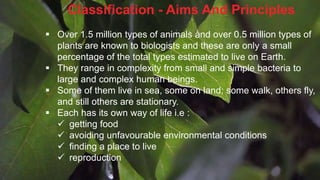
Classification: Aims and principles
- 1. Classification - Aims And Principles Over 1.5 million types of animals and over 0.5 million types of plants are known to biologists and these are only a small percentage of the total types estimated to live on Earth. They range in complexity from small and simple bacteria to large and complex human beings. Some of them live in sea, some on land; some walk, others fly, and still others are stationary. Each has its own way of life i.e : getting food avoiding unfavourable environmental conditions finding a place to live reproduction
- 2. When there are so many diverse kinds of organisms, it becomes difficult to learn about the characteristics of each. To study such a large collection, biologists classify the organisms into groups and subgroups and for this task they require some system. Biological classification is a method by which biologists divide organisms into groups and subgroups.
- 3. Aims of Classification Taxonomy: (Greek, Taxis= Arranged, Nomes= Law) “ The branch of biology which deals with classification is called taxonomy” Systematics: “ The branch which deals with the evolutionary history of organisms is known as systematics.” The main aims of both these branches are; To determine similarities and differences among organisms so that they can be studied easily. To find the evolutionary relationships among organisms.
- 4. Basis of Classification Classification is based on relationship amongst organisms and such relationship is got through similarities in characteristics. These similarities suggest that all organisms are related to one another at some point in their evolutionary histories. However, some organisms are more closely related than others. For example sparrows are more closely related to pigeons than to insects. It means that the former two have common evolutionary histories.
- 5. When biologists classify organisms into groups and subgroups, the similarities are seen in external and internal structures and stages of development. Modern genetics provides another type of information to taxonomists. The similarities and differences in the DNA of two studied organisms can be used for getting idea about similarities and differences in their structures andfunctions.
- 6. Taxonomic Hierarchy “ The groups into which organisms are classified are known as taxonomic categories or taxa (singular “taxon”). The taxa form a ladder, called taxonomic hierarchy. All organisms are divided into five kingdoms. So kingdom is the largest taxon. On the basis of similarities, each kingdom is further divided into smaller taxa in the following way: Phylum (Division: for plants and fungi): A phylum is a group of related classes.
- 7. Class: A class is a group of related orders. Order: An order is a group of related families. Family: A family is a group of related genera. Genus: A genus is a group of related species. Species: A species consists of similar organisms. Members of lower taxon resemble one another more than do the members of a higher taxon. Table 3.1 illustrates the classifications of humans (Homo sapiens) and pea (Pisum sativum).
- 8. Table 3.1: Simple classification of two organisms Taxa Human Pea Kingdom Animalia Plantae Phylum Chordata Magnoliophyta Class Mammalia Magnoliopsida Order Primates Fabales Family Hominidae Fabaceae Genus Homo Pisum Species H. sapiens P. sativum
- 9. Species - The Basic Unit of Classification Species is the basic unit of classification. A specie can be defined as : “A species is a group of organisms which can interbreed freely among them and produce fertile offspring, but are reproductively isolated from all other such groups in nature.” Each species possesses its own distinct structural, ecological and behavioural characteristics.
- 10. In the definition of species we must emphasize “in nature” because two organisms related to two different but closely related species can cross-breed under artificial conditions. In such unnatural crosses they produce infertile offspring. For example, a cross between a male donkey and a female horse produces an infertile offspring i.e. mule (Figure) Figure : Taxonomic hierarchy
- 11. Figure : Infertile mule The criteria of interbreeding cannot be used for species recognition in organisms who reproduce asexually and do not interbreed with one another (for example many unicellular organisms).